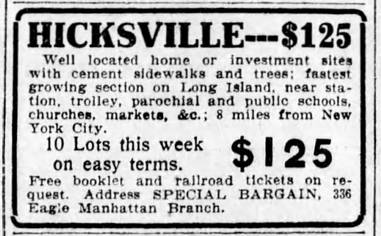Some Places Are More Equal Than Others
Not every town on the Island could inspire glowing advertising copy. The earlier ad for lots in Massapequa mentioned a bay, the ocean, some beautiful fresh-water lakes, and (glossing over the fact that all towns funneled into the same East River tubes) even the "great terminal" in Manhattan through which new commuters from the town were to travel. In contrast, the modest ad below took a pragmatic stance.

Brooklyn Daily Eagle, April 16, 1912
There were good reasons for this. Most New Yorkers already had some idea of Hicksville. Its hotels, especially the Grand Central, long had attracted New Yorkers who wished to hunt or go for sleigh rides. In recent years, it had become the end point of a trolley line that penetrated into Queens. The first Vanderbilt Cup race had gone through Hicksville, as did the 1909 and 1910 races. It was a "real place" - Mr. Heinz, who could put factories wherever he chose, had built a big plant there. Did anyone reading this advertisement need to be told much more about Hicksville?
The other side of the coin, of course, was that for all its advantages, the village had no bays or lakes. It was about as far from the seashore as one could get on Long Island. It would have been impossible to argue that Hicksville was remarkably picturesque. But did that matter very much? The advertisement told prospective commuters things they needed to know. The village had trolley service, schools, churches, and good shopping. It was only eight miles from New York City (well, from the Queens County line). Houses built on lots near the station allowed commuters to walk to their trains, even in bad weather. Lakes and seashores would have been appealing, but commuters only cared about such things on weekends; during the work week, Hicksville gave commuters what they wanted.
A Personal Reminiscence:
I still recall very clearly my first visit to Hicksville, when I was seven years old. As the real estate agent showed a house to my parents, he told them that from it my sister would be able to walk a few blocks to what would become the old High School, that the new High School would be even closer, and that my elementary school would be almost as close. My father observed that he would be able to walk to the railroad station. I realized then that I was looking at my new home.
***

